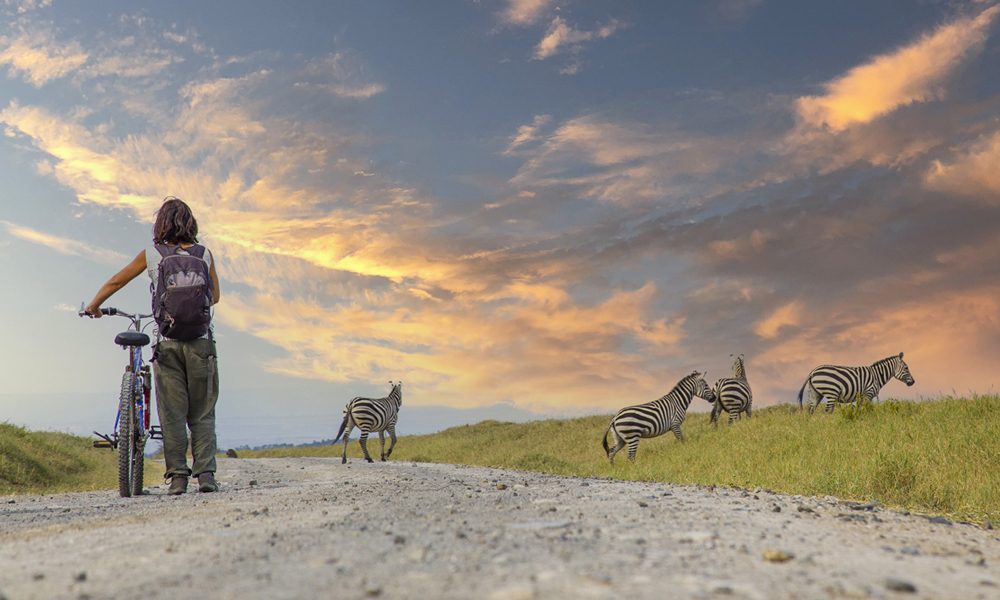Call /WhatsApp: +255 788 738494

Kenya Safaris which is the birthplace of the safari and remains an ideal destination for wildlife lovers. Bordering the Indian Ocean and crowned by Mount Kenya, the country features small farms, rolling hills, and vast golden savannas. More than a century ago, tourists were drawn here by tales of wild animals, and that legacy continues today.
Kenya safaris highlight the country’s dramatic landscapes, from national parks to reserves. These wild spaces are home to the famous Big Five: elephant, lion, leopard, rhinoceros, and buffalo.
Safaris in Kenya are among the world’s top travel experiences. Expert local guides and tailor-made tours are essential for a seamless journey. At Kiriwe Travel and Trekking Safaris, a locally owned operator, we specialize in offering personalized Kenya safari tours. Our 4X4 Land Cruiser Jeeps seat six, include long-range radios, and feature a pop-up roof for easier wildlife viewing and photography.
Whether you prefer a budget-friendly safari, a comfortable yet affordable experience, or a luxury Kenya safari, Kiriwe Travel and Trekking Safaris can help. Our knowledgeable team, combined with customizable packages, ensures one of the best safari experiences in Kenya.
The Masai Mara is one of Kenya’s most iconic safari destinations. Spanning 583 square miles of wilderness, it lies along the Tanzanian border with grassy plains and rolling hills. The Mara and Talek rivers flow through the reserve, which is named after the Maasai people, the ancestral inhabitants.
Wildlife here includes lions, cheetahs, elephants, leopards, black rhinos, hippos, and zebras. The Mara is also world-famous for the annual wildebeest migration, one of the greatest natural spectacles on Earth.
Amboseli is Kenya’s second most visited park after the Masai Mara. It is known for large herds of elephants and striking views of Mount Kilimanjaro, just across the border in Tanzania. Visitors may also encounter buffalo, zebra, wildebeest, hippo, hyena, lions, and wild dogs.
During heavy rains, the central basin floods, attracting throngs of wildlife. In 1991, Amboseli was declared a UNESCO-MAB Biosphere Reserve, highlighting its ecological importance.
Tsavo East is Kenya’s largest park, covering 4,535 square miles. Its flat, dry terrain dotted with baobab trees is ideal for spotting the Big Five. Safaris typically take place south of the Galana River, where vast areas make solitude possible.
The Voi and Galana rivers and the Aruba Dam attract countless birds. Another unique feature is the Yatta Plateau, a 180-mile lava flow parallel to the Mombasa Highway. Tsavo is also home to rare animals like oryx, lesser kudu, and the tiny klipspringer antelope.
Samburu, located in northern Kenya, offers remote and uncrowded safari experiences. Its landscapes include rocky hills, semi-desert terrain, and the Ewaso Ngiro River. This environment supports animals adapted to dry conditions.
Here, visitors may also meet the Samburu people, related to the Maasai, who move their cattle depending on grazing patterns. Uniquely, Samburu is one of the few places in Africa where camels can be spotted on safari.
Lake Naivasha is a freshwater lake about 90 minutes from Nairobi. Its yellow-barked acacia trees, hippos, and over 400 bird species make it a popular stop. Giraffes, zebras, buffalo, and monkeys often graze nearby.
Beyond the lake, visitors can explore Elsamere, once the home of Born Free author Joy Adamson, and enjoy tea overlooking the water.
Lake Nakuru National Park is famous for its flamingos, which often blanket the Rift Valley lake in pink. The park also shelters black and white rhinos, lions, leopards, hippos, and the endangered Rothschild’s giraffe.
The southern end of the lake is one of the best wildlife viewing areas. Lions and leopards are often found resting in the forest below Flamingo Hill.
Just outside the capital city, Nairobi National Park is one of the smallest in Africa at only 45 square miles. Despite its size, it offers Big Five sightings, except for elephants.
The park’s open plains and acacia-lined rivers are home to lions, rhinos, and many other animals. Visitors can also stop at the nearby Sheldrick Wildlife Trust to see orphaned baby elephants.
Ol Pejeta, on the Laikipia Plateau, combines grasslands, forests, and wetlands. It is renowned for rhino conservation and is home to two of the world’s last remaining northern white rhinos. More than 140 black rhinos also live here, protected by expert teams.
The Sweetwaters Chimpanzee Sanctuary, located within Ol Pejeta, provides a safe home for orphaned chimpanzees.
Covering 277 square miles, Mount Kenya National Park protects the slopes of Africa’s second-highest peak. Wildlife includes elephants, buffalo, rhinos, leopards, and rare species such as the albino zebra.
Since 1997, it has been a UNESCO World Heritage Site, valued for its biodiversity and cultural significance to local Kikuyu, Meru, and Embu communities.
Meru National Park lies east of the town of Meru, about 200 miles from Nairobi. Once devastated by poaching, it was restored in the early 2000s and is now a thriving reserve.
Wildlife includes elephants, leopards, cheetahs, rhinos, Grevy’s zebras, and hippos. Meru is also where Elsa the Lioness, made famous by Born Free, is buried.
Do you need help?
Send us details